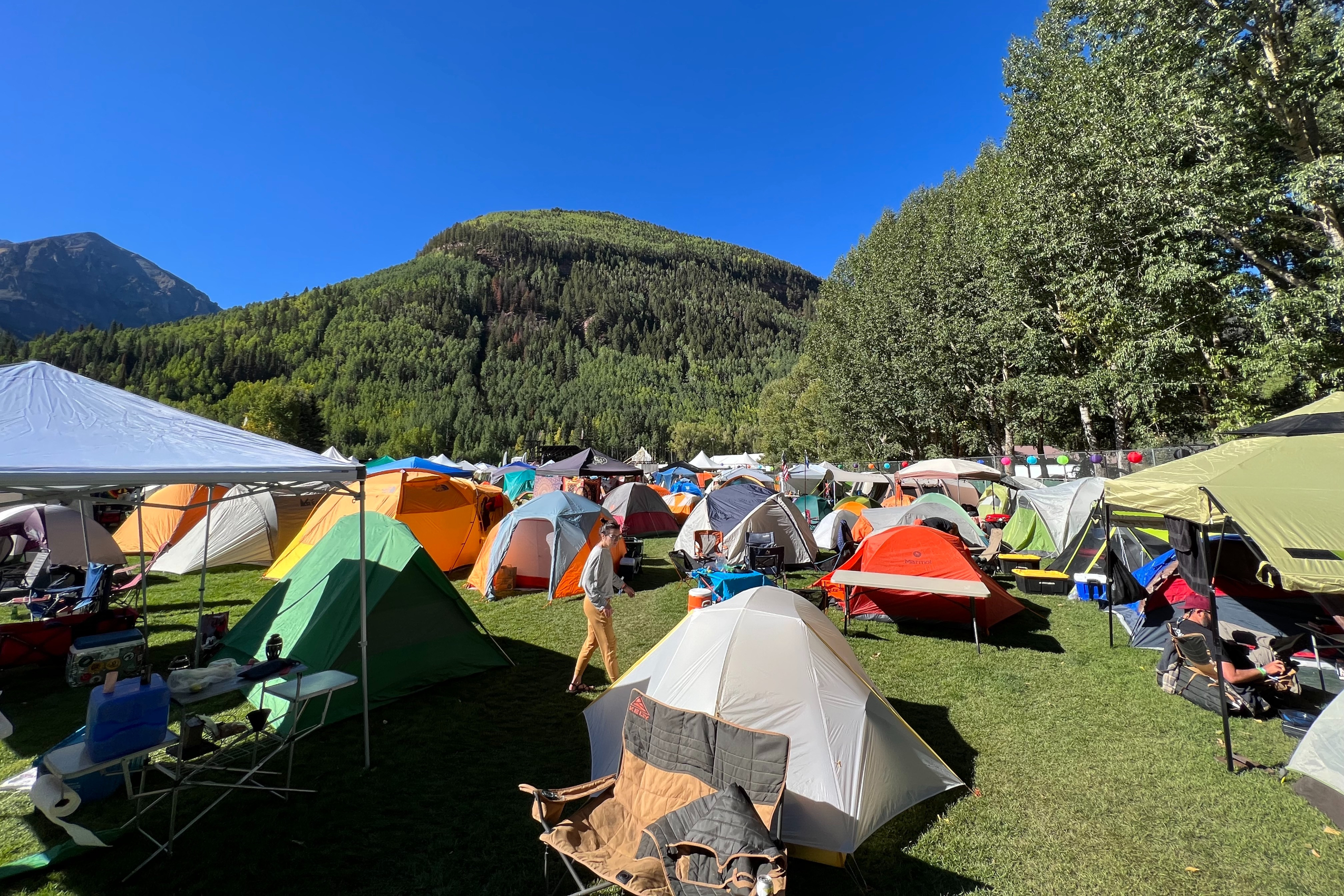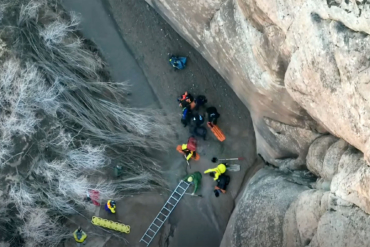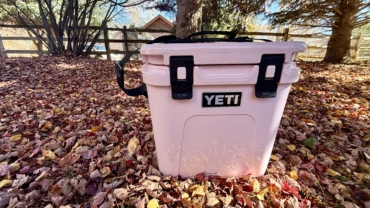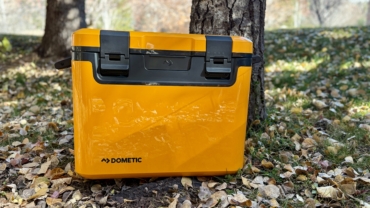There’s no arguing the fact that Colorado is a beautiful place for camping. The Rocky Mountains rise up over the land in all their purple majesty; the rivers flow full of life, with brown, rainbow, and cutthroat trout, winding through spectacular valleys, canyons, and woods. Deer, elk, and moose roam freely. Birds fill the skies and the trees. And scattered across the land are some of the most picturesque campsites you can imagine.
Except, you are not alone. In fact, in order to reach any of those campsites, you’ll probably have to sit in I-70 traffic, bumper to bumper, crawling along at a snail’s pace with thousands of other hopeful campers. Even if you leave work early on a Friday, you’ll get stuck in it — like some kind of admissions queue for the outdoors.
And then, by the time you finally reach your intended destination, it’s getting dark, and all of the spots are taken. You drive in circles looking for an open site at campgrounds, on BLM, and up dirt roads with dispersed campsite pull-offs. All to no avail.
Until you see it: One last available spot. You make a beeline for it, but at the last second, a Subaru Outback decked in gear and Native bumper stickers swoops in front of you.
You’ve been skunked. Again. But what’s new about camping in Colorado?
Whether this sounds all too familiar or confirms your worst vacation planning fears, take heart. While Colorado camping is great if you can get it, there are some hidden gems out there that offer just as much relaxation and picturesque views.
Crunching the Camping Numbers: Colorado

I’ve lived the exact scenario above too many times to count. And it’s bound to happen even more as camping becomes more popular in Colorado and around the country. A report by the Center for Western Priorities (CWP) showed that between 2014 and 2020, the estimated peak season occupancy of reservable campsites in Colorado jumped from 41% to 71%.
And that’s the average camping occupancy for the entire state of Colorado. When you look at popular campgrounds specifically, like Aspenglen Campground in Rocky Mountain National Park, or Black Canyon of the Gunnison National Park South Rim campground, expected occupancy is over 90%.
In fact, the Dyrt’s 2023 Camping Report showed that, across the nation, it was five times harder for people to find campsites when they wanted one than it was in 2019. That report estimates that there are over 80 million campers in the US — 7.3 million of whom were first-timers in 2022.
It’s busy out there. And oftentimes, that makes it hard to pull off an impromptu or weekend camping trip. At the very least, it means you have to deal with throngs of other people — often when that’s exactly what you’re trying to get away from.
According to several recent roundups that used different metrics to calculate camp index scores, Colorado isn’t the best place to camp, anyway. Largely because of the crowds. But these scores also took into account the number of national parks and landmarks, the number of hiking trails, average fuel prices, yearly average rainfall, diversity of plant and animal species, and annual outdoor death rates for each state.
We took those scores into consideration. But we also used The Camping Crunch data from the CWP, and our own firsthand experience to compile GearJunkie’s own list of the best states to camp in — that aren’t Colorado.
Best States for Camping Outside Colorado
1. Wyoming

You could call Wyoming a “hidden gem” for camping, although it really isn’t that hidden. It’s just largely unvisited. And between the Grand Tetons, Devil’s Tower, Medicine Bow, Fort Laramie, Fossil Butte, and, of course, a gigantic portion of Yellowstone National Park, Wyoming has some spectacular landscape.
With a state population of just 578,000 (compared to Colorado’s 5.8 million) spread out over 98,000 square miles, there’s also a lot of space to get away from your fellow humans.
According to CWP, Wyoming’s rate of occupancy has increased by 23% since 2014 — which is to say, camping is getting very popular in Wyoming. But the overall expected occupancy is still only at 48%. So even at peak season, over half of the reservable campsites should still be available.
Camping in Wyoming
Visit Devil’s Tower (pictured), a popular landmark and climbing area. There is Belle Fourche River Campground in Devil’s Tower National Monument, or primitive dispersed camping in the nearby Black Hills National Forest.
The Vedauwoo rocks are another popular recreation area between Laramie and Cheyanne. There’s the Vedauwoo Campground right next to the rocks, and nearby there is Twin Lakes Creek Campground, Happy Jack Campground, and Montecristo Campground in the nearby Curt Gowdy State Park. There’s also plenty of dispersed camping in the area.
Just north of Jackson, Wyoming, is Grand Teton National Park. Not only is it full of incredible hiking and backpacking opportunities, but it’s also a huge area for climbers and mountaineers looking to test their mettle on the state’s tallest mountains. There are six established campgrounds in Grand Teton (Gros Ventre, Jenny Lake, Signal Mountain, Colter Bay, Lizard Creek, and Headwaters).
And if all of those are full you can check out camping in the John D. Rockefeller Memorial Parkway, National Forest, or at private campgrounds in the local area.
And of course, we couldn’t mention camping in Wyoming without talking about the iconic Yellowstone National Park. Wyoming lays claim to one of the largest portions of Yellowstone, which spans three separate states. There are 12 campsites within Wyoming’s portion of Yellowstone with over 2,000 sites between them. And then there’s also a lot of privately owned campgrounds just outside of the park.
2. Montana

If you’re looking for wide open spaces and big wild places, Montana’s got a surplus of both. According to the state website, there are 55 state parks scattered across the Treasure State. Within those, there are over 500 reservable campsites. And that doesn’t account for all of the dispersed camping — which there is a lot of. Montana has over 30 million acres of BLM land. That’s over a third of the state. All of which is fair game for free camping.
And with a population of just 1 million people, you aren’t going to be running into a lot of crowds out there at Montana’s campgrounds. Even the most popular tourist destinations like Glacier National Park are expansive enough to find plenty of fresh air and room to breathe it.
Camping in Montana
One of the most magnificent, and comparatively unvisited National Parks in the entire country, is Glacier National Park. It is a must-see if you plan on visiting Montana for some camping. There are 13 campgrounds scattered throughout the Park — some are first-come first-served, and others are by reservation only. There is also wilderness camping for backpackers who want to get into the deep wilderness. However, that requires getting a permit ahead of time.
Montana’s Big Sky is known mostly for its skiing. But in the summertime, it’s a great basecamp for hiking, rafting, fishing, paddling and, of course, camping. Within 20 miles of the town of Big Sky, there are five campgrounds: Red Cliff, Moose Creek Flat, Swan Creek, Greek Creek, and Spire Rock.
And Montana, like Wyoming and Idaho, is home to a portion of Yellowstone National Park. And while the only camping within the park is on the other side of the Wyoming border, there is private and dispersed camping just outside of the Park on the Montana side.
3. Idaho

Lots of people think of Idaho and picture potato fields, wind farms, and long, straight roads through flat, empty country. But there’s another side of Idaho a lot of people overlook. It’s got 27 state parks and access to the North Eastern corner of Yellowstone National Park. There are the Bitterroot Mountains, Salmon River Mountains, and the Sawtooth Mountains in the north, and the Caribou Range and Owyhee Range in the south.
Idaho’s got everything Colorado has, except the crowds — for now, that is. But the Gem State is growing in popularity quickly. Boise is the fastest-growing city in the U.S., according to the Department of Labor. And with a population of 1.9 million, the state may soon have many of the same problems that Colorado campers face.
But for now, camping in Idaho is still generally much easier, much more solitary, and just as much fun.
Camping in Idaho
One of the coolest (and most unearthly) recreation areas in Idaho is the Craters of the Moon National Monument & Reserve. And while there is only one 43-campsite campground in the Monument & Reserve, you can also get a permit at the visitor center to camp at either the Craters of the Moon Wilderness or the NPS Preserve and BLM Monument. If you visit in the wintertime, camping is permitted. But only in the Lava Flow Campground, Devil’s Orchard parking area, and Tree Molds parking area, likewise with a permit.
In the southern part of the state, near the border with Utah, there’s also the City of Rocks National Reserve. There is one campground at this reserve with 69 standard sites and three group sites. Backcountry camping is allowed in the Indian Grove area with a permit. Outside of the Reserve, near Almo, Idaho, there are also a handful of private campgrounds as well.
Then there are also 17 state parks, all of which offer great camping opportunities close to mountains, lakes, and rivers.
And, of course, there is also the western entrance to Yellowstone National Park in Idaho. While the only campgrounds within the park are in Wyoming, there are dispersed camping and private campgrounds right outside of the park.
4. New Mexico

Camping in New Mexico is more diverse than most people imagine. The further south you go, the more inhospitable the desert terrain becomes — which appeals to some campers. But the central and northern parts of the state are more temperate, easier to survive in, mountainous, and generally more fun for car camping and backpacking.
The estimated occupancy of reservable sites only ever gets as high as 42%. And with Carlsbad Caverns National Park, Cibola National Forest, Carson National Forest, Gila National Forest, and more, there is a lot of unique and beautiful country to see. And there are a lot of old Native American ruins, tucked in the wilderness, that are exceptional areas to camp and explore.
Camping in New Mexico
The Carlsbad Caverns National Park is one of New Mexico’s most popular natural attractions. But there’s a catch with camping there: there are no established campgrounds. All campers in Carlsbad must obtain a permit from the visitor’s center on the day of arrival to use the backcountry. Check out the National Parks webpage on Carlsbad for more details.
White Sands National Park is another famous attraction in the Land of Enchantment. And while there are no established campgrounds at White Sands, either, backcountry camping is permitted with a permit. (Note: Currently, backcountry camping is closed, for rehabilitation of camping sites — no opening date has yet been established.) However, check on sites like the Dyrt, and you’ll find lots of highly rated private campgrounds surrounding the National Park.
At Bandelier National Monument, there are two campgrounds: one for groups of under 10 people, and another for groups of over 10 people. There is also backcountry camping available by permit.
Then, there is a lot of great dispersed camping and BLM in the northern part of the state, where the Sangre de Christo Mountains spill into New Mexico from Colorado.
5. Utah

Look, we know — Utah campers face a lot of the same problems that Colorado campers do with 3.3 million people living there. Weekend traffic to the mountains and desert can be bad from places like Salt Lake City, and campsite competition gets fierce in popular areas like Moab.
Where it’s different is the fact that Utah only has 50% expected capacity during its busiest times of the year, according to the CWP’s research. Which is relatively low for a place with this caliber of camping.
Adding to that is 2.3 million acres of BLM (read: dispersed camping) that make camping options truly plentiful and accessible throughout Utah.
Camping in Utah
National Parks like Arches and Bryce Canyon have over 200 campsites each. Then, there’s Zion National Park, Capitol Reef National Park, and Canyonlands National Park, each of which is similarly bursting with established campgrounds.
Then, on top of all of that, there are also 43 State Parks in Utah. Goblin Valley is a favorite and has its own campground, but is also surrounded by BLM-dispersed camping. Dead Horse Point is another one, not far from Moab, that has two established campgrounds within the park, several just outside of it, and a lot of dispersed camping surrounding the Park.
Honestly, the number of camping options in Utah rivals that of any other state (which is a big part of why it made this list). Campgrounds are everywhere in this state. Most of them are spectacular and located adjacent to great mountain biking, hiking, water, and beautiful natural landmarks.
6. Arkansas

The Ozark Mountains of Arkansas are still largely under the radar, and abundant with primo camping options. No doubt, the Netflix show “Ozark” drove a recent spike in tourism and camping numbers. But by and large, the state is littered with campgrounds and is not overly busy.
At peak season, the CWP expects around 56% occupancy of the state’s campgrounds. And with 52 State Parks and seven National Parks, there’s beautiful geography to camp among. It’s a great place to explore, especially if you’re into watersports. Lakes and rivers abound, and kayaking, canoeing, SUP boarding, boating, and fishing are huge in this area.
Camping in Arkansas
Thirty-two of Arkansas’ State Parks feature their own campgrounds. Many of them are established campgrounds with access to water, electricity, and dump sites for RVs. But there are also a lot of hike-in tent sites and primitive dispersed camping. For the full list of State Parks in Arkansas and campgrounds within them, check out the Arkansas State Parks camping accommodations page.
Arkansas is also home to Hot Springs National Park, which has camping at Gulpha Gorge Campground, as well as at Ozark National Park, which has Wolf Pen Campground. And established campgrounds and dispersed camping along the Arkansas River are downright abundant.
7. South Dakota

With less than a million people living in the entire state, you are all but guaranteed to find a camping spot when you want one in South Dakota. Badlands and Wind Cave National Parks offer front country reservable campgrounds and are surrounded by other paid camping options. And if you want to find a free spot, 280,000 acres of BLM offers plenty.
Camping in South Dakota
The most popular natural outdoor attraction in South Dakota is, without a doubt, the Badlands National Park. There are two campgrounds — Cedar Pass Campground and Sage Creek Campground. And between the two of them, there are 118 campsites available to reserve ahead of time or on-site.
Wind Cave National Park is one of the oldest Parks in the NPS system. It features a beautiful expanse of prairie overhead, where bison, elk, and more wildlife roam freely. But it also encompasses the cave system itself, which is one of the largest and most complex in the world. Elk Mountain Campground is the only designated campground in the area. But it has 62 spots so it’s usually easy to get one to yourself.








